Wright Glider Video - Picture
More Aviation History
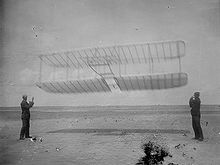
|
|
Wright Glider

Picture - Wilbur (left) and Orville flying their 1901 glider as a kite
The Wright brothers designed, built and flew a series of three manned gliders in 1900-1902 as they worked towards achieving powered flight. They also made preliminary tests with a kite in 1899. In 1911 Orville conducted tests with a much more sophisticated glider. Neither the kite nor any of the gliders was preserved, but replicas of all have been built.
1899 kite
The 1899 kite, which Wilbur flew near his home in Dayton, Ohio had a wingspan of only 5 feet (1.5 m). This pine wood and shellacked craft, although too small to carry a pilot, tested the concept of wing-warping for roll control that would prove essential to the brothers' solving the problem of controlled flight. The Wrights burned the craft along with other trash in 1905.
1900 glider
The 1900 Wright Glider was the brothers' first to be capable of carrying a man. Its overall structure was based on Octave Chanute's two-surface glider of 1896. Its wing airfoil was derived from Otto Lilienthal's published tables of aerodynamic lift. The glider was designed with wing warping capability for full-size testing of the concept first tried on the 1899 Wright Kite.
The glider was first flown as an unmanned kite on October 5, 1900 near Kitty Hawk, North Carolina. Next, Wilbur rode as pilot while men on the ground held tether ropes attached to the airborne craft. Subsequently, Wilbur made about a dozen free flights on a single day, concluding the season's test efforts. The brothers abandoned the glider and it eventually disappeared in the region's severe storms.
1901 glider
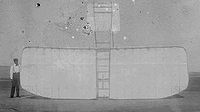
Picture - Orville with the 1901 glider, its nose pointing skyward.
The 1901 Wright Glider was the second of the brothers' experimental gliders. They tested it over the Kill Devil Hills, four miles south of Kitty Hawk. The glider was similar to the 1900 version, but had larger wings. It first flew on July 27, 1901, and was retired on August 17. During this time it made between 50 and 100 free flights, in addition to tethered flights as a kite.
The wing ribs flexed under the weight of the pilot, distorting the airfoil shapes of the wings. The brothers fixed the trouble, but the wings still produced much less lift than expected, and wing-warping sometimes made the glider turn opposite the intended direction. After testing concluded, the brothers stored the glider in their camp shed. The shed and glider were badly damaged later by windstorms. The wing uprights were salvaged for the 1902 Glider, but the rest was abandoned.
As a result of lift and "drift" (drag) measurements taken with the tethered glider, the brothers concluded that Lilienthal's data were inaccurate. Upon returning to Dayton, they designed and built a small wind tunnel to collect their own data.
1902 glider
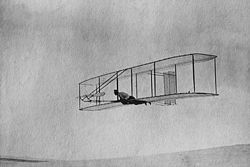
Picture - The 1902 Wright Glider (Wilbur piloting) on one of its early test flights before replacement of the fixed double rear vertical rudder with a single steerable rudder.
The 1902 Wright Glider was the third free-flight glider built by the brothers. This was their first glider to incorporate yaw control by use of a rear rudder, and its design led directly to the powered 1903 Wright Flyer.
The brothers designed the 1902 glider during the winter of 1901-1902. The wing design was based on data from extensive tests of miniature airfoils in their homemade wind tunnel. They built the components of the glider in Dayton and completed assembly at their Kill Devil Hills camp in September 1902. Testing began on September 19. The new rear rudder improved turning control, but several times the pilot was unable to stop turning and collided with the ground. The brothers decided to make the rear rudder steerable to solve the problem. With this modification, they achieved true control and made between 700 and 1000 glides (as estimated by the brothers, who did not keep detailed records). The longest glide was measured and timed at 622.5 ft (189.7 m) in 26 seconds.
In 1903 they brought the 1902 glider out of storage and flew it again to hone their piloting skills while preparing the powered Flyer. One of their photographs shows they installed a second vertical fin as part of the steerable rear rudder, matching the original design and also that of the powered Flyer's twin rear rudder. After their successful powered flights, they put the glider back in storage at camp before returning home for Christmas. When they next visited Kitty Hawk in 1908 to test their improved Flyer III, Outer Banks weather had taken its toll: the storage shed and glider inside were wrecked.
Specifications
Source: 1902 Wright Glider - National Air and Space Museum
General characteristics
Crew: 1
Length: 16 ft 1 in (4.9 m)
Wingspan: 32 ft 1 in (9.8 m)
Height: 8 ft (2.4 m)
Wing area: 305 ft² (28.3 m²)
Empty weight: 117 lb (53 kg)
Performance
Range: 622.5 ft (189.7 m)
1911 glider
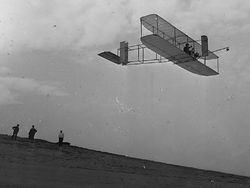
Picture - The 1911 glider over the Kill Devil Hills. Library of Congress Wright Collection.
In 1911 Orville Wright returned to the Kill Devil Hills with a new glider, accompanied by his English friend Alec Ogilvie. Orville intended to test an automatic control system on the glider, but did not because of the presence of reporters (he eventually perfected the system in a powered airplane in 1913). The glider had what is now considered a 'conventional tailplane' rather than the front mounted elevator. The pilot also was seated with hand controls, rather than lying prone in a cradle, as with the original gliders. In a 65 km/h(40 mph) wind on October 24, 1911, Orville soared above Kill Devil Hill for 9 minutes 45 seconds, breaking the brothers' previous record of 1 minute 12 seconds set in 1903 with the 1902 glider. The new record stood for ten years, until broken in Germany.
General characteristics
Crew: 1
Length: 21.5 ft (6.5 m)
Wingspan: 32 ft (9.8 m)
Height: ()
Wing area: 300 ft² (28 m²)
Empty weight: 170 lb (77 kg)
Performance
Replicas
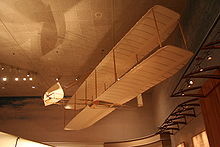
Picture - Replica of 1902 Wright Glider on display at the Smithsonian National Air and Space Museum
A number of replicas of the gliders exist. Wright brothers historian Rick Young of Richmond, Virginia has built 9 accurate working replicas of all of the Wright gliders and the 1903 Flyer. Young's 1902 gliders have appeared in numerous films and television documentaries, including a 1986 IMAX On the Wing. One of his 1902 replicas is on display at the Smithsonian National Air and Space Museum's Wright Brothers gallery. The Virginia Aviation Museum at Richmond International Airport is home to the Wright 1899 Kite, the 1900, 1901 and 1902 gliders and the 1903 Flyer, all built by Young.
A replica of the 1902 glider is also on display at the U.S. National Soaring Museum in Elmira, New York.
Another replica, a half scale model is on display at the Wings Over the Rockies Air and Space Museum in Denver, Colorado.
A team led by Nick Engler of the Wright Brothers Aeroplane Company has also built replicas of all three gliders.
Crouch, Tom, "The Thrill of Invention." Air&Space/Smithsonian, April/May 1998, pp. 22-30.
Wescott, Lynanne, Paula Degen (1983). Wind and Sand: The Story of the Wright Brothers at Kitty Hawk. New York, New York: Harry N. Abrams, Inc.. Includes excerpts from diaries and correspondence pertaining to the Wright Brothers and their experiments.
More airplanes.
Source: WikiPedia